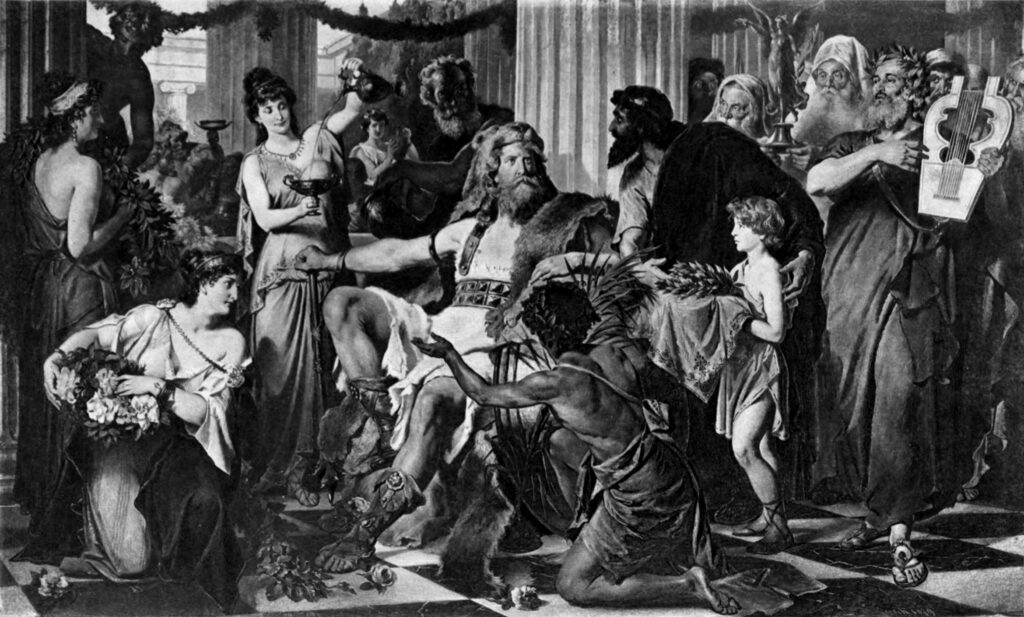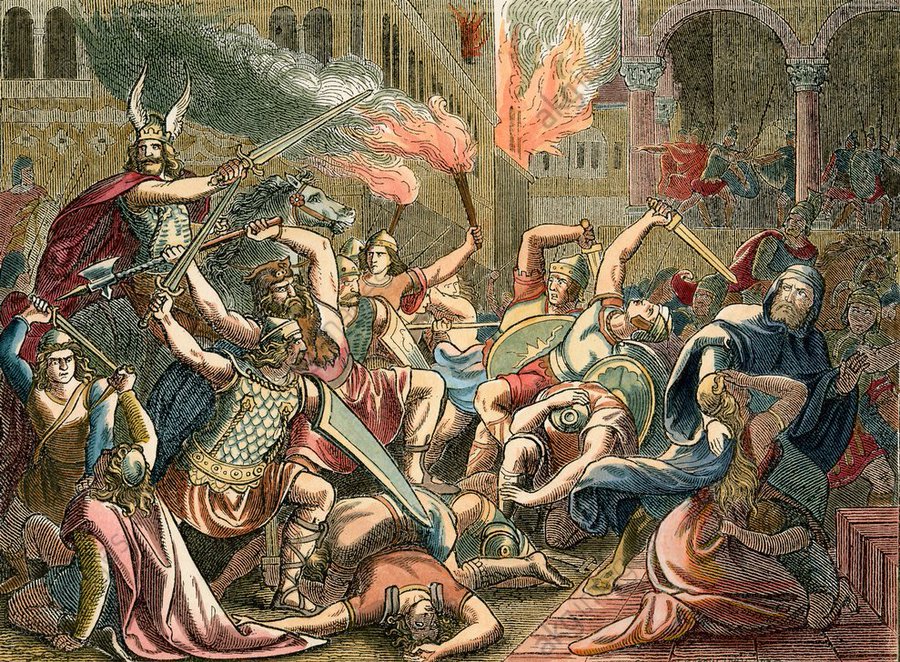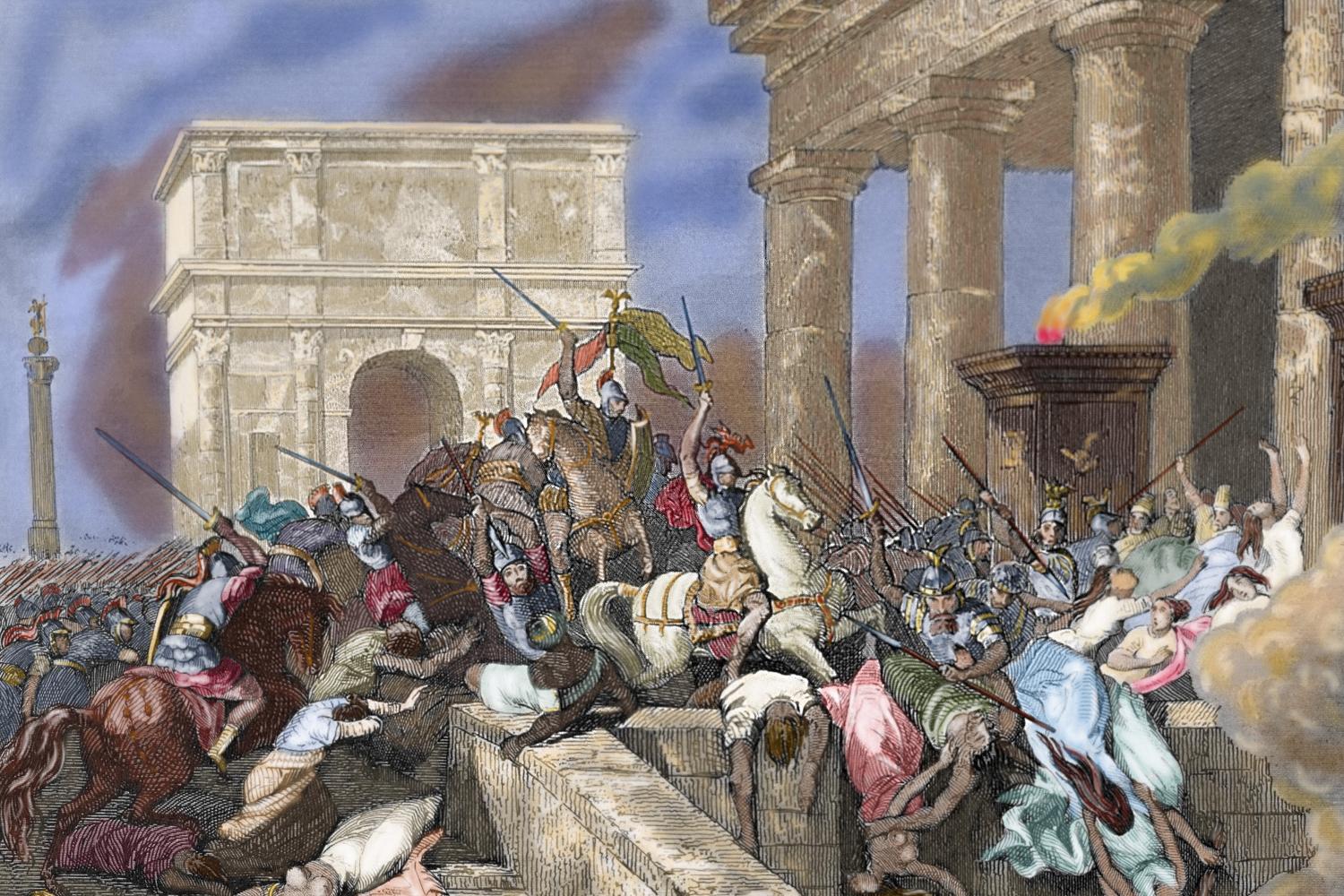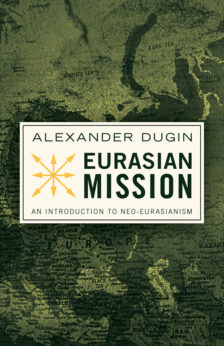The sack of Rome in 410 AD is a prism in historical thought: it is alternately the decisive end of Roman greatness, a mere footnote in its decline, a moral travesty, or a justified response to corruption and collapse.
Perhaps even more controversial than the event itself is its perpetrator: Alaric I, King of the Visigoths. The contemporary poet Claudian characterizes his actions as “how / pirates act, terrors to the sea / when they see their life of crime / finally runs aground.” Centuries later, Gibbon would describe him as “a victorious leader, who united the daring spirit of a barbarian with the art and discipline of a Roman general.” Generally, Alaric has been viewed negatively; he was a victorious leader, but a barbarian nonetheless, who sacked the eternal city and brought about its symbolic end. Whether this act was a catalyst of collapse or a long-overdue coup de grâce is up for debate, but in both cases Alaric’s profile is reduced to a caricature at best.

Alaric
Recently, the historian Douglas Boin has taken a more “modern” approach to the barbarian king with Alaric the Goth. In this work, Alaric is characterized as a refugee, an ancient incarnation of today’s raft-bound Somalis assailing the shores of southern Europe. Somehow this is supposed to be sympathetic.
“Alaric’s actions,” he writes, “forced a difficult, long-overdue conversation about acceptance, belonging, and the rights of immigrant communities.” The Goths were “immigrants,” separated by “border patrol,” alienated by a “new combustible mix of xenophobia and cultural supremacy.” A glowing Atlantic review describes these anachronisms as “slyly allusive” “winks” to the reader. The reviewer goes on to compare Alaric and his army to Iraqi jihadists planting roadside bombs, as if the point hadn’t been driven home that this is a work lampooning anti-immigration ideas, merely wearing the skin of an ancient history book.
In reality, these “winks” have all the subtlety of hammering a nail into the reader’s skull. Perhaps behind the eye socket, to fully lobotomize their ability for historical thought. Boin expects readers to absorb the idea that Alaric sacked Rome because of stochastic terrorism against immigrants, mistreatment by toga-clad ICE agents, and a lack of social programs. While the traditional view of Alaric can be criticized as lacking sophistication, this framing is far worse. Like many other elements of modern historiography, it overfits the past to current hot-button political issues – in the process, squashing any inspiration or vitality that may have been present before.
A new paradigm for the first king of the Visigoths is needed: one that more accurately reflects the nuances of contemporary Rome, and the actions of the man who toppled it.
I
According to the Roman-Gothic chronicler Jordanes, Alaric was born on Peuce Island in modern-day Romania. His birth year is uncertain, and his early life is murky at best. However, we can be fairly certain that he was of the Thervingian line, a storied group of Goths who had engaged in near-constant battle with Rome for a century before Alaric’s birth. Jordanes places him as an heir to the Balti dynasty, and thus nobility; however, again, there is a great deal of ambiguity on the matter.
Alaric’s childhood is once again defined by assumptions. He would have likely been born during the Gothic conflicts with the Huns, and a young child during their migration across the Danube, after which followed the ten-year Gothic War with Rome (376–382). When that war was settled by a treaty in 382 AD, Alaric would have been perhaps in his early teens; he would come of age during the time of standoffish, shaky relations between the quasi-autonomous Goths and their Roman rulers. Part of the peace treaty that led to this arrangement held that the Goths would supply troops to the Roman legions, which would lead to Alaric’s entry into Roman service in 392 AD.
As borderland peoples, the Goths fulfilled an awkward social role in the Roman world. They were semi-autonomous within Roman borders, yet typically served as slaves or servants to wealthy Romans near the Balkan frontier. Their soldiers often fought in distinct Gothic auxiliary units during Roman military campaigns. Among this milieu, Goths in military service were increasingly able to rise to citizenship in Rome – ethnic Romans (correctly) saw this as a threat, leading to the “xenophobia” described by Boin. The Goths that attained aristocratic status were still veritable barbarians; they had grown up in the remote and harsh Balkans, among their own people. Even during Roman military service they had remained semi-segregated in auxiliary or majority-minority units, thus typically avoiding full cultural assimilation. This was typical of many barbarian peoples during this era. Rome’s borders were insecure and its cultural dominance was waning, leading to a prominent and uncomfortable cultural multipolarity within its volatile borders.
Ethnic Romans living in the heart of the Empire saw this as a weakening of Roman rule – a deracination of the empire for short-term military gains, and a temporary fix to Rome’s demographic collapse. While Gibbon points to Christianity as the primary driver behind the collapse of Western Rome, this was perhaps a greater contributing factor; overextended and with constantly shifting alliances, Roman rulers had to give increasingly more ground to barbarian peoples in order to maintain its borders and population. Boin posits that this “xenophobia and cultural supremacy” was unwarranted… yet dances around the fact that it was this deracination that led to Rome’s fall.
But I digress. Alaric entered the military world during this odd time in Roman-Gothic relations under the Gothic soldier Gainas, and by 391 was leading a warband of Goths and other borderlands peoples in a haphazard invasion of Thrace. This invasion was perhaps more akin to a bandit operation than a true military occupation, and it was soon stopped by the Roman general Stilicho.
This would be the first of many encounters between Alaric and Stilicho. The dynamic between the two men would in many ways go on to decide both of their destinies. At this time in 391, Stilicho was a Roman general nearly at the height of his power and influence; he was well respected in the court of Theodosius. The Eastern emperor had even offered Stilicho his niece Selena’s hand in marriage eight years prior, due to his success as an envoy in Persia.
From 392 to 394, Alaric rose in the Roman military hierarchy, and by 394 would find himself in command of an impressive array of Gothic auxiliaries alongside this now-magister militum of the East. This combined force was rallied to oust the would-be usurper Eugenius, placed upon the throne by the Frankish general Arbogast. Alaric now found himself at the forefront of the power struggle over a collapsing Rome, leading his own people into intra-Roman strife for the promise of recognition and power upon victory. Over the prior few years, tensions between Goths and Romans had receded; Alaric likely hoped for (or was directly promised) increased Gothic autonomy and personal power upon victory over Eugenius and Arbogast.
In 394, the Eastern emperor invaded the West, and the two armies met at the Battle of the Frigidus. Alaric’s troops, Gothic foederati, were deployed first and foremost among Theodosius’ forces, in what essentially amounted to human wave tactics. At the end of the struggle, at least ten thousand Goths lay dead on the field, the bulk of the casualties on the victorious Eastern side. On top of this decimation of Alaric’s men – which was perhaps an intentional outcome by Theodosius – Alaric was not given the title of magister militum, nor command over any Roman troops. This was seen as an unconscionable insult to Alaric and to the Gothic people, who had just sacrificed thousands for Theodosius’ regime.
Thus, it is at this point that Alaric rose to prominence not just as a general but as a Gothic leader, a sort of populist figurehead for his spurned and brutalized kinsmen. After working within “the system” – providing military service and sacrificing thousands of his men for Theodosius – he had been met with a stunning rebuke by the emperor.
Just as Arbogast’s usurpation was put down, Alaric’s mutiny began. From Jordanes’ Gothic History:
The contempt of the Goths for the Romans soon increased, and for fear their valor would be destroyed by long peace, they appointed Alaric king over them. He was of famous stock, and his nobility was second only to that of the Amali, for he came from the family of the Balthi, who because of their daring valor had long ago received among their race the name Baltha, that is, The Bold. Now when this Alaric was made king, he took counsel with his men and persuaded them to seek a kingdom by their own exertions rather than serve others in idleness.
The Goths under Alaric would now serve Gothic interests: an independent kingdom, with exclusive power. A homeland.
II
Soon after the Battle of Frigidus, Theodosius died of a rapid illness – leaving his two young sons as the de jure rulers of Rome. In reality, Stilicho took the helm in the West, and Rufinus in the East. Both men plotted to seize control from the other and reunite Rome under sole leadership. Stilicho maintained a military presence in Greece, beginning what would become a low-level, indecisive campaign against Rufinus.
Alaric, seeking control over neither empire but merely an independent homeland, would use this conflict to his advantage over the next fifteen years. It is important to note that at the time of his rise to the Gothic throne, Alaric was only around twenty-five years of age. Spurned by Roman leadership and reeling from the loss of many of his men, his response was not to negotiate or play courtly politics at a distance, as an older and more tempered ruler might.
Instead, he began to wage war.
Gothic forces first moved into Thessaly, taking food and provisions by force. There is debate if this initial campaign was prompted or directed by Rufinus in the East; at the very least, Rufinus was not opposed to the presence of a military force that may deter Stilicho from invading Constantinople. If this was the case, then Alaric’s campaign in Greece was likely less pillage-oriented than presented by Claudian, who was indeed a Western Roman historian employed by Stilicho. Either way, over the course of the year Alaric moved south, and began a campaign of sackings. Athens was nearly flattened, among other cities and villages.
However, Stilicho had conflicting ambitions in the region: asserting himself in the East, and perhaps invading Constantinople if necessary. After Stilicho sailed from Italy, he and Alaric’s forces drew closer over the course of 395. A surprise attack by Stilicho in southern Greece forced Alaric to begin a withdrawal from the Western magister militum; however, Rufinus convinced Arcadius (the nominal ruler) to order a withdrawal of the nominally Eastern legions under Stilicho’s command. Stilicho, who could have likely ended the Gothic insurgency in mere weeks, was forced to withdraw to Italy.
At this point, Alaric and his people had little interest in the strategic nuances of Roman rule. They merely aimed to present themselves as enough of a threat to demand respect, in order to negotiate an agreement that recognized their legitimacy. The full strategic picture is unclear to current historians, as the only major accounts of the period come from select Roman sources, but it seems that both sides saw Alaric as either a potential pawn or a threat to be foisted onto the other. One can assume that Alaric was perfectly satisfied with this designation; if Rome were to legitimize a Gothic homeland and trade relations, it did not matter to him if it was a diplomatic move in service of some imperial dispute.
After Rufinus’ murder in late 395, this goal would begin to materialize for Alaric, via an alliance with Eastern Rome. De facto rule of Eastern Rome shifted to the consul Eutropius, an ambitious eunuch, who declared Stilicho an enemy of Rome and appointed Alaric to magister militum of Illyricum. With this position, Alaric would no longer need to pillage cities for provisions; they would be legally supplied by Roman cities.
Still in sole pursuit of a homeland, Alaric entered a four-year period of peace, engaging in negotiations with Arcadius’ regime under Eutropius. This situation seemed to develop positively for the Goths… until Eutropius, too, was deposed. Arcadius had less of a taste for complex scheming than the eunuch consul, and transferred Illyricum to Western Rome. In effect, this action meant that Alaric, suddenly stripped of his title and entitlements, was now a problem for Stilicho.
Alaric had now trusted two Roman emperors, and been flagrantly dismissed by both. Theodosius and Arcadius had used the Goths as a mere pawn in service of their own interests, dismissing his fairly reasonable efforts to serve and be rewarded with a proper Gothic homeland.
Upon this betrayal, for the second time, Alaric began to wage war. This time he would not remain content with mere supplies in Greece; instead, he would march to Italy and demand, not request, Roman recognition.
III
From 402 to 410, Alaric and his Gothic army mounted a protracted insurgency against Roman Italy, beginning with banditry and escalating to ransoms of entire cities. Once again aiming to pose enough of a threat to demand recognition, he raided settlements and travelers along northern transportation arteries, remaining somewhat elusive in the early months. Stilicho soon marched north with an army to meet the Gothic threat, and the two forces met less than a year into Alaric’s occupation.
Two battles were fought, both clear victories for Stilicho; Alaric’s family and much of his pillaged treasure were captured by the victorious general. However, Stilicho did not wipe out or even militarily cripple the Goths, instead allowing them to retreat across the Alps and resettle in Illyricum. Stilicho’s decision to show mercy to the Goths likely sowed initial seeds of doubt in Stilicho among Honorius’ court, and even today remains unclear to historians. On a purely political level, Stilicho may have wanted to retain Alaric as a potential buffer against Constantinople. Perhaps due to his previous experience commanding troops alongside Alaric, Stilicho hoped that he could use the Goths as cannon fodder once again. Additionally, at this point Rome faced deep instability, threatened by various different barbarian groups; Alaric may have seemed more reasonable due to his previous actions, and was thus allowed to retreat in order to retain a “known” enemy that may outcompete unpredictable future threats. The historian Guy Halsall argues that Stilicho’s military victory over the Goths at this time may have been incomplete, and that he was thus forced to acquiesce to terms favorable to Alaric. Other historians argue that Western Rome’s military was already overextended by this point in 402, and rather than pursue the Goths for a total victory, Stilicho aimed merely to continue the barbarian juggling act that had defined the prior decade of Roman politics.
Whatever the reason, Alaric was made magister militum once again by the West, and some among the Western Roman court began to suspect Stilicho’s judgment, which would later manifest in a plot against him.
In effect, this act of mercy by Stilicho made the sack of Rome inevitable. Alaric had been pushed back but by no means defeated, and a courtly plot against Stilicho began to brew soon after, forging a new administration which would remove Alaric’s title again and refuse such negotiations in the future as a matter of principle.
This series of events would come to a head five years later, as another group of barbarians crossed the nearly undefended Rhine frontier, once again forcing Stilicho to deploy his strained forces. Alaric, lying in wait and amassing more forces during the intermediate years, once again marched into Italy.
This second attack was a more measured show of force than the prior, which had been in some sense an act of rage. Accordingly, its goals were defined and terms were quickly offered to the Western Roman Senate: pay four thousand pounds of gold, or face a full-scale Gothic invasion of Rome’s heartland. Stilicho elected to pay the Gothic king, and Alaric, satisfied with this show of force and ransom payment, pursued no further action.
At this point, Alaric found himself on terms of mutual respect with Stilicho. The latter clearly recognized the threat that Alaric presented, and perhaps aimed to use him in a future offensive against the East or future barbarian upstarts. But after being betrayed twice by Roman authorities, Alaric was likely suspicious of fully trusting the commander, and remained prepared for further military action.
Older, wiser, and more hardened than before, Alaric understood that Roman military power was tenuous at best, and that instead of merely posturing between East and West, he would likely need to leverage internal Western strife to forge any sort of meaningful, lasting agreement in favor of Gothic sovereignty. After easily extorting his latest ransom, he knew his position would be favorable if another opportunity presented itself; theorists of war would say that he had momentum.
That momentum would soon become necessary. In May of 408, Arcadius died and was succeeded by Theodosius II; during the instability that accompanied this regime change, Stilicho’s enemies in the Senate acted against him. Key politicians – led by Olympius, minister to Honorius – ousted Stilicho’s supporters in the imperial court by force, and soon executed the man himself. Additionally, Olympius’ men began to massacre barbarian foederati and their families; they viewed Stilicho, a Vandal himself, as the leader of a barbarian-sympathetic coalition, and aimed to cut off not only the head of the plot but destroy its rank and file as well.
As Alaric’s continued survival was the primary point of contention for Olympius and his supporters, the Gothic king was immediately declared an enemy of the state, and once again stripped of his titles. However, this time he was not caught surprised, and was prepared to move immediately. Further, his ranks were bolstered by the surviving soldiers of Olympius’ purges, their families in tow. These men were, unsurprisingly, passionate for revenge. Alaric’s newly strengthened force, numbering around 30,000, marched for Rome.
Alaric passed through the Alps without incident, and by September 408 had besieged Rome. The 800,000 people inside the walls of the Eternal City were left without food or supplies. Starvation quickly took its toll. During Alaric’s previous invasion of Italy, a senator had called his demands for gold “not peace, but a pact of servitude” – and this time, his demands were even higher. 5,000 pounds of gold, 30,000 pounds of silver, 3,000 dyed hides, 4,000 silk tunics, and 3,000 pounds of pepper would buy Rome’s freedom from Gothic blockade.
The precious metals alone would be worth some $120 million today, with the total ransom amounting to an exorbitant fortune. When negotiations opened up, Roman officials balked at the offer, refusing to pay. One emissary even threatened that the people of Rome had not forgotten their martial heritage, and would perhaps launch a counterattack on the entrenched barbarians outside their city. Alaric’s response was to laugh – the people of Rome were largely urban and unsoldierlike, and by this point most were falling over from starvation. “The thicker the grass, the easier it is mowed,” he added sarcastically. According to Zosimus, the Senate was still unwilling to pay, and continued to aim for a lower sum. In one of these desperate appeals, Roman negotiators asked what the citizens of Rome would be left with after paying. Alaric replied: “Their lives.”
When the people of Rome could no longer go without food, they acquiesced to Alaric’s ransom. No “mowing” would occur during this siege. The Goths took their plunder and relieved the pressure on Rome, withdrawing to Etruria to continue negotiations. Simultaneously, Alaric’s brother-in-law Ataulf marched across the Alps to join the main Gothic force.
However, the Roman court at Ravenna had lost its patience for negotiating with barbarians, and in a moment of utter strategic ineptitude, Honorius ordered military action against the Goths. He sent Olympius and a force of Huns to intercept Ataulf, and called five Dalmatian legions to bolster Rome’s defenses.
Both of these initiatives failed. First, the legions called to garrison Rome (under the general Valens) made the inexplicable decision to instead confront Alaric directly in Etruria. This led to a total defeat and decimation, with only a handful of survivors reaching the city they were charged with protecting. Soon after, Olympius’ force, too, was routed by Ataulf’s men in northern Italy. The victorious Gothic contingent joined Alaric’s main force in Etruria, only adding to Alaric’s military momentum.
Known tactical details of these battles are few, but Gibbon’s characterization of Alaric as a commander with the “art and discipline of a Roman general” comes to mind; he was intimately familiar with Roman tactics of all sorts, and by this point had a deep understanding of how to anticipate and counter them.
Once again, negotiations opened up, this time significantly more tense. Alaric asked for four provinces – Venetia, Istria, Noricum, and Dalmatia – and annual grain provisions, in exchange for Gothic service as foederati in Roman wars. Honorius was deeply offended by these demands, and responded with a rather rude letter, which was read publicly to Alaric by Jovius, a Roman envoy and an old friend to the Gothic king. Even Jovius found the emperor’s response unconscionable and absurd. Historian John Bagnell Bury writes: “The German deeply resented the language in which it was couched, and rising up in anger he ordered his barbarian host to march to Rome to avenge the insult which was offered to himself and all his kin.”
The Goths tempered Jovius’ rage and sent a smaller offer in response, as a last-ditch effort at peace. Perhaps this was a test to see if Honorius would be open to negotiations at all, or had merely been dragging the Goths along to amass a stronger military response.
When this offer, too, was rejected, they took Jovius’ advice. In 409, the Goths marched to Rome for the second and final time.
Difficult, militant negotiations between Alaric, Rome, and Ravenna continued, with the Visigothic army once again stationed outside Rome’s walls. More courtly drama followed: Alaric appointed a puppet emperor, who proved to be ineffectual; Honorius prepared to flee Italy, but when new forces arrived in Ravenna, he returned to his hostile posture against the Goths.
The final straw for Alaric’s desire to negotiate legitimately came in the summer of 410. Waiting outside Ravenna for a meeting with Honorius, he and a detachment of men were attacked (apparently at random) by Roman soldiers under the Goth Sarus. This force was routed and Alaric survived – this time, much angrier than he had been after mere hostile letters.
Soon after, Rome would pay for Honorius and Sarus’ mistakes. The city was besieged in August of 410, and this time no honest negotiations followed.
An apocryphal retelling by Procopius of the events that followed tells a rather dramatic – and ironic – story. Procopius holds that Alaric offered 300 slaves as collateral and an expression of good faith to the people of Rome. In reality, these young men were elite soldiers “of good birth,” who would act as a Trojan horse. After a few days of “eager service,” the Goths would massacre their masters and open the Salarian Gate to Alaric’s full army. While many historians find it likelier that the Salarian Gate was opened by allies inside Rome or by citizens desperate for food, this story has held on in the popular imagination, and it is not entirely improbable.
If Procopius’ retelling is correct, then Rome – the city legendarily founded by the descendants of Trojan refugees – had forgotten the mythical lessons of its forefathers. Just as Troy had fallen to the Greeks, Rome fell to the Goths, and the Eternal City was sacked for three bloody days in 410 AD. After eight centuries of untouchability, Rome fell to the barbarians that it had for so long relied on in battle, yet betrayed and scorned in politics.
IV
Alaric’s sack of Rome was contemporarily seen as an act of barbarity, a sin which the historical record has never fully forgiven. The untouchable city had been set to the sword and flame, its wealth and splendor carried off by dreaded “skin-clad barbarians.”

Alaric storms Rome
But in the world we face today, is a new interpretation not in order? Alaric was born into a time of declining legitimacy for Rome; the Empire’s borders were unstable, its internal politics in a state of constant, violent flux. Agreements were not honored; invasions and courtly plots constantly threatened stability and reasonable political expectations.
Liberal historians like Douglas Boin see Alaric as a parallel for modern refugees or illegal immigrants, positing that the core lesson of Rome’s sack is that foreigners must be accommodated at all costs. This is an egregious overfitting of history to ideology, one that drastically understates the role of covenants between rulers and peoples, in both Alaric’s time and our own.
In truth, Alaric’s story is one of broken promises. It is the story of a man seeking legitimacy within “the system” of his era, yet meeting treachery at every turn. From 382 on, the Gothic people were bound to Rome by treaty, making them semi-independent as long as they fulfilled certain obligations, namely military service. Beyond that, the expected norms of contemporary Roman politics held that outstanding service would be rewarded; that men who defined themselves via prowess in battle would be able to seek power for themselves and privileges for their people.
Alaric pursued this path for decades, working within the conventional morality and political norms of his time. He negotiated in good faith, and with each military offensive merely aimed to demonstrate his capabilities in the interest of gaining Roman legitimacy and a recognized homeland for the Visigoths.
But in a declining empire, these norms are no longer concrete, and guarantees crumble nearly as soon as they are made. The memory of such a state shortens as it declines, eventually reaching a state of the unending present, with ephemeral rulers and ephemeral alliances. In this environment, long-term projects like ethnic sovereignty via decades of service are subject to the whims of whatever scheming consul has taken the helm at the immediate moment. As Alaric would gradually recognize over the course of his life, the only way to assert oneself in this environment is via force – the kind that cannot be ignored or foisted upon a political rival.
So, if the modern nation-state is to draw any lesson from Alaric, it should not be to accept infinite immigrants and cater to their every whim. A more appropriate lesson is found in the mechanics of legitimacy – and a warning of what happens when legitimacy is cast aside for temporary political ambitions.
A state that shows itself to be in this sort of imperial decline forces increasingly “barbaric” measures to be taken by those seeking legitimate goals. When a covenant (or perhaps a social contract) is not upheld by those in power, it gradually forces interests that would be otherwise useful assets to turn against the state itself, and assert themselves via destruction. When the mechanics of meritocracy and the established norms of rising to power are disregarded by scheming eunuchs in power… eventually, Rome is sacked by its former clients, men who could have once served its interests in both war and peace.
~
Regarding Alaric himself, the Gothic king presents many faces to the modern observer. One interpretation not often explored is derived from Nietzsche: Alaric, and by extension the Visigothic people, as a political version of Thus Spoke Zarathustra’s three metamorphoses.
During Alaric’s youth, the Goths had been beaten down by the Huns and then subdued by the Romans; they accepted foederati status out of necessity, and remained second-class citizens. However, as Alaric came of age and entered military service, Goths increasingly proved themselves competent in service to the Roman fighting machine, their harsh homeland and warrior spirit animating them to great heights in battle. Alaric himself first rose to power in this way, via his service to Theodosius. In this we see the transformation of the sheep to the camel; the passive creature to the workhorse, seeking greatness via service and responsibility – though still within accepted norms.
At the Battle of the Frigidus, we see Alaric and his people transform from the camel to the lion. There, as the smoke cleared and the dead were collected, the sight of ten thousand Gothic casualties in service of an emperor that considered them disposable animated Alaric and his people to rebellion. With the election of Alaric as king and mutiny against Roman power, they would “seek a kingdom by their own exertions rather than serve others in idleness.” They would bow to no one, and seek power via force. This is the morality of the lion, the fiercely independent warrior. “I will” had overtaken “Thou shalt.”
This stage persisted for the following decades of off-and-on conflict with Rome. However, Alaric still defined his posture in contention with Roman norms; he rebelled within an established strategic framework, threatening cities and demanding negotiation.
When this finally proved an impossible approach in 410, we see a version of Nietzsche’s final metamorphosis: from lion to child.
Among popular recent interpretations, Michael Kulikowski’s 2006 work offers the compelling idea that Alaric’s sack of Rome was an “admission of defeat, a catastrophic failure.” To some extent, this is poignant and true; Alaric’s sack of Rome was an expression of the failure of negotiation, the repeated collapse of a more conventional approach. But it was not exactly a failure of Alaric himself, nor a necessarily disappointing conclusion.
Instead, one must see this act as characterized by the grim acceptance by Alaric that nothing legitimate could come from Rome any longer; that a new future must be carved out in an unprecedented manner; that piratical, ancient norms were once again the necessary approach.
Though this comparison to Nietzsche is strained by the fact that his metamorphoses deal with moral stages of development and Alaric’s with the political realm, it is nonetheless a loosely applicable parallel to the Visigoths’ struggle for independence. With the sack of Rome, Alaric and his men accepted that they faced a new frontier, one not defined by Roman hegemony and negotiation. They had been rebuked at every turn, punished for their adherence to older norms and expectations of good-faith, long-term alliances.
And indeed, the decades that followed proved unprecedented for the Visigoths. Alaric I died of illness shortly after the sack of Rome, and as such he would not be privy to their kingdom, diaspora, and key role in the geopolitics of Late Antiquity. However, it was his leadership that forged them into a defined people, and set them on the path of fierce independence; his actions laid the groundwork for the Visigoths to reach the heights of their power under the King Euric later in the 5th century.
~
Today, we face a world not entirely different from the later period of Western Rome. The world’s preeminent powers seem to be in states of imperial decline, and Fukuyama’s prophecy of the “end of history” seems increasingly unrealistic.
If this is indeed the case, perhaps we will soon face barbarians at the gates.
And they will not be foreigners angry about our immigration policies, as Boin suggests; they will be men spurned by traditional structures of power, men betrayed at every turn despite outstanding capabilities. They will be men who have tried every other option, and now face the grim realization that Rome must be sacked.

The Sack of Rome
Bibliography
Burns, Thomas. Barbarians within the Gates of Rome: A Study of Roman Military Policy and the Barbarians, CA. 375–425 A.D. Indianapolis: Indiana University Press, 1994.
Bury, John Bagnell. History of the Later Roman Empire, Volume I. New York: Dover Publications, 1958.
Claudian, quoted in Boin (2020).
Gibbon, Edward. The Decline and Fall of the Roman Empire. London: W.W. Gibbings, 1890.
Hodgkin, Thomas. Alaric, from Encyclopedia Britannica Vol. 1 (11th ed.). Cambridge: Cambridge University Press, 1911.
Jordanes. The Gothic History of Jordanes, tr. Charles C. Mierow. London: Oxford University Press, 1915.
Kulikowski, Michael. Rome’s Gothic Wars: From the Third Century to Alaric. New York: Cambridge University Press, 2006.
Nietzsche, Friedrich. Thus Spoke Zarathustra, tr. Walter Kaufmann. New York: Penguin, 1954.
Procopius. History of the Wars, tr. Dewing. London: William Heinemann, 1916.
Zosimus. Historia Nova: The Decline of Rome, tr. James J. Buchanan & Harold T. Davis. San Antonio: Trinity University Press, 1967.









